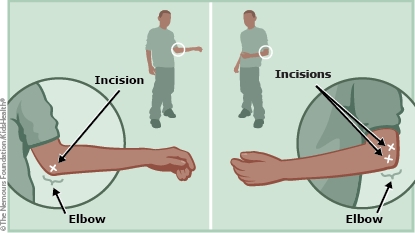After OCD Lesion Fixation of the Elbow: How to Care for Your Child
The elbow needs to heal completely from the surgery. With the surgeon's supervision, your child eventually can return to normal activities.


An osteochondritis dissecans (OCD) lesion is a small area of damaged bone and cartilage that can become loose or detached from the rest of the bone. Your child has had surgery to repair an OCD lesion in the elbow joint. The surgeon secured the OCD lesion to the rest of the bone and removed some of the damaged tissue to help the area heal.
The goal of the surgery is to get your child's elbow back to its normal level of functioning. Your child will wear a splint for a while to help the elbow rest and heal from the surgery.

-
Give your child any medicines as prescribed by your health care provider.
-
Mild fever (less than 101.5°F [38.6°C]) is common in the first day or two after many surgical procedures. Your child's health care provider will give you advice about when to be concerned about a fever in the days after the procedure.
-
Do not remove the surgical dressings. The health care provider will remove them at your child's follow-up appointment.
-
If your child has swelling, numbness, coldness, or tingling in the elbow, loosen the bandage and have your child elevate the arm above heart level.
-
Your child should not shower until after the first post-operative appointment.
-
Every few hours for the first 3 days after surgery, place a cold pack or plastic bag of ice around the elbow portion of the splint for 20–30 minutes at a time. Wrap the cold pack or plastic bag in a towel to prevent the splint from getting wet.

-
If you haven't already, make a follow-up appointment with the surgeon.
-
Teens who drive should not resume doing so until the surgeon says it's OK.

Your child:
-
Is unable to urinate (pee) by the evening of the surgery.
-
Has a fever higher than 101.5°F (38.6°C).
-
Has swelling or numbness that is not relieved by loosening the bandage and elevating the arm.
-
Continues to have severe pain more than 48 hours after the procedure.
-
Has a lot of drainage from the surgical site.

Your child: